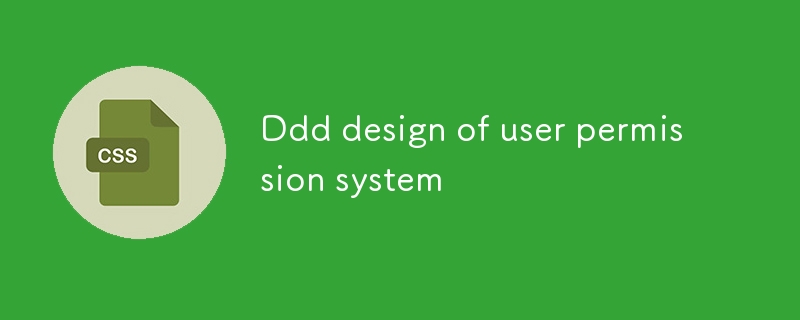Ddd design of user permission system
Domain-Driven Design (DDD) is a software design methodology that can be used to enhance the flexibility, scalability, and maintainability of a user permissions system. By applying DDD principles, developers can create a system that is more easily ada

How can DDD principles be applied to enhance the design of a user permissions system?
Domain-Driven Design (DDD) provides a methodology for structuring software solutions based on the domain concepts they represent. By applying DDD principles to a user permissions system design, developers can create a more flexible, scalable, and maintainable solution.
Key steps in using DDD for user permissions design:
- Identify the domain concepts. The first step is to identify the core domain concepts involved in a user permissions system, such as users, roles, permissions, and resources.
- Define the relationships between concepts. Once the domain concepts have been identified, the relationships between them need to be defined. For example, users can be assigned to roles, and roles can be granted permissions to access resources.
- Create domain models. The domain concepts and relationships are then used to create domain models, which represent the business logic of the system. These models should be independent of any specific implementation details.
- Implement the domain models. The domain models are then implemented in code, typically using an object-oriented programming language.
- Test the system. The final step is to test the system to ensure that it meets the requirements and functions as expected.
What are the key benefits of adopting a DDD approach in a user permissions system design?
Adopting a DDD approach in a user permissions system design offers several key benefits:
- Improved flexibility: DDD helps to create a more flexible system that can be easily adapted to changing requirements.
- Increased maintainability: By separating the domain logic from the implementation details, DDD makes the system easier to maintain and update.
- Enhanced scalability: DDD promotes the use of modular and loosely coupled components, which can be scaled independently to meet growing needs.
How can Domain-Driven Design improve the flexibility and maintainability of a user permissions system?
Domain-Driven Design improves the flexibility and maintainability of a user permissions system in several ways:
- Flexible and adaptable: DDD promotes the use of modular and loosely coupled components, which can be easily rearranged or replaced to accommodate changing requirements.
- Separation of concerns: DDD helps to separate the domain logic from the implementation details, making the system easier to understand and maintain.
- Testability: DDD encourages the use of unit testing to verify the behavior of individual components, which helps to improve the overall quality and reliability of the system.
The above is the detailed content of Ddd design of user permission system. For more information, please follow other related articles on the PHP Chinese website!

Hot AI Tools

Undresser.AI Undress
AI-powered app for creating realistic nude photos

AI Clothes Remover
Online AI tool for removing clothes from photos.

Undress AI Tool
Undress images for free

Clothoff.io
AI clothes remover

Video Face Swap
Swap faces in any video effortlessly with our completely free AI face swap tool!

Hot Article

Hot Tools

Notepad++7.3.1
Easy-to-use and free code editor

SublimeText3 Chinese version
Chinese version, very easy to use

Zend Studio 13.0.1
Powerful PHP integrated development environment

Dreamweaver CS6
Visual web development tools

SublimeText3 Mac version
God-level code editing software (SublimeText3)

Hot Topics
 Vue 3
Apr 02, 2025 pm 06:32 PM
Vue 3
Apr 02, 2025 pm 06:32 PM
It's out! Congrats to the Vue team for getting it done, I know it was a massive effort and a long time coming. All new docs, as well.
 Building an Ethereum app using Redwood.js and Fauna
Mar 28, 2025 am 09:18 AM
Building an Ethereum app using Redwood.js and Fauna
Mar 28, 2025 am 09:18 AM
With the recent climb of Bitcoin’s price over 20k $USD, and to it recently breaking 30k, I thought it’s worth taking a deep dive back into creating Ethereum
 Can you get valid CSS property values from the browser?
Apr 02, 2025 pm 06:17 PM
Can you get valid CSS property values from the browser?
Apr 02, 2025 pm 06:17 PM
I had someone write in with this very legit question. Lea just blogged about how you can get valid CSS properties themselves from the browser. That's like this.
 Stacked Cards with Sticky Positioning and a Dash of Sass
Apr 03, 2025 am 10:30 AM
Stacked Cards with Sticky Positioning and a Dash of Sass
Apr 03, 2025 am 10:30 AM
The other day, I spotted this particularly lovely bit from Corey Ginnivan’s website where a collection of cards stack on top of one another as you scroll.
 A bit on ci/cd
Apr 02, 2025 pm 06:21 PM
A bit on ci/cd
Apr 02, 2025 pm 06:21 PM
I'd say "website" fits better than "mobile app" but I like this framing from Max Lynch:
 Comparing Browsers for Responsive Design
Apr 02, 2025 pm 06:25 PM
Comparing Browsers for Responsive Design
Apr 02, 2025 pm 06:25 PM
There are a number of these desktop apps where the goal is showing your site at different dimensions all at the same time. So you can, for example, be writing
 Using Markdown and Localization in the WordPress Block Editor
Apr 02, 2025 am 04:27 AM
Using Markdown and Localization in the WordPress Block Editor
Apr 02, 2025 am 04:27 AM
If we need to show documentation to the user directly in the WordPress editor, what is the best way to do it?
 Why are the purple slashed areas in the Flex layout mistakenly considered 'overflow space'?
Apr 05, 2025 pm 05:51 PM
Why are the purple slashed areas in the Flex layout mistakenly considered 'overflow space'?
Apr 05, 2025 pm 05:51 PM
Questions about purple slash areas in Flex layouts When using Flex layouts, you may encounter some confusing phenomena, such as in the developer tools (d...






